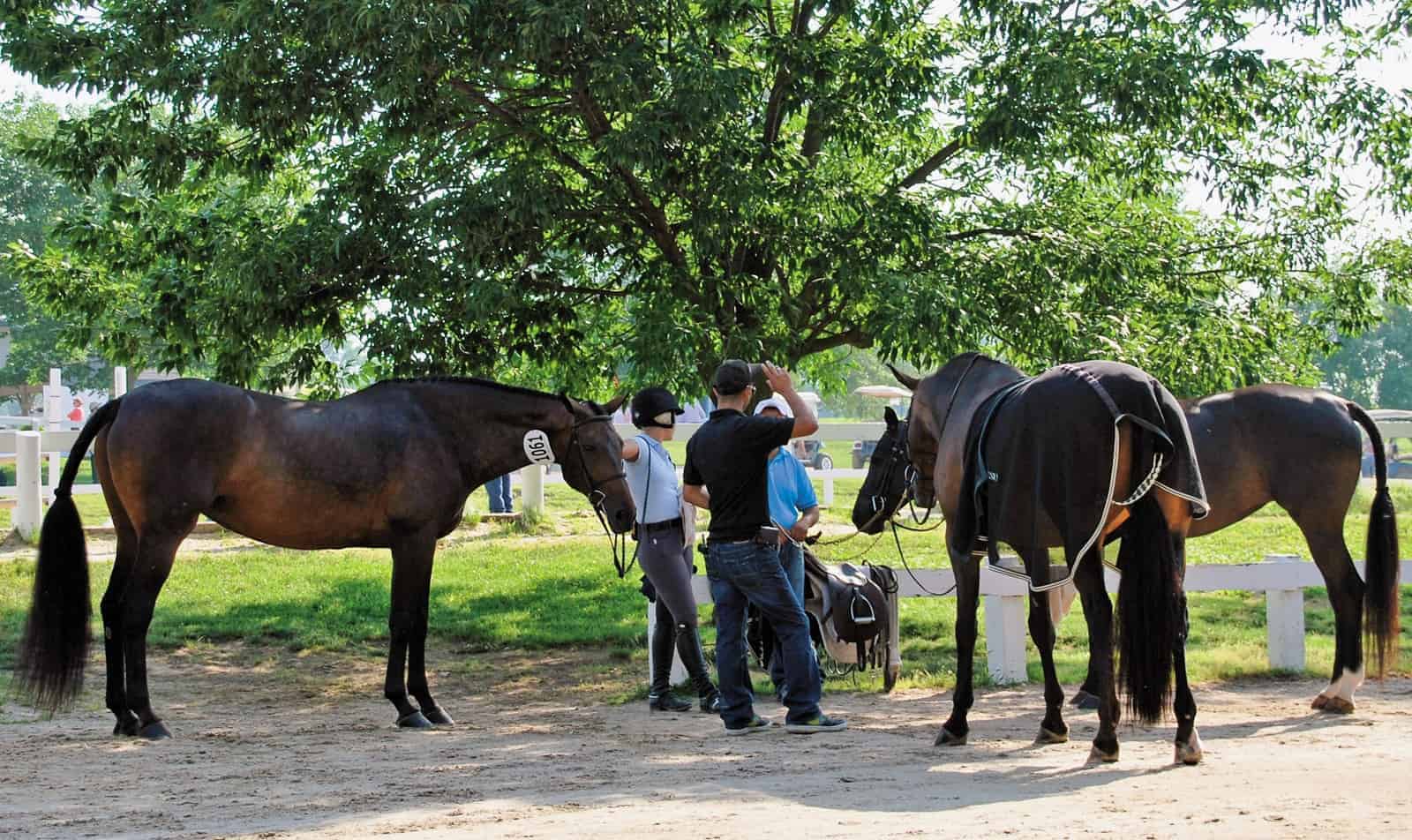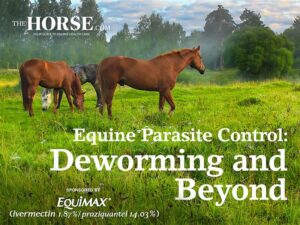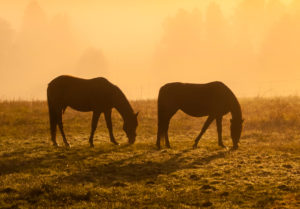Biosecurity for Show Horses

Keeping your equine athletes safe from infectious disease
Whether you’re hauling your horses to local shows, clinics, or trail rides, if they’ll be exposed to others, biosecurity is an important aspect of travel.
Even if your horses stay on your property or at the farm where you board, they will be exposed to infectious diseases at some point in their lives if there are new horses that come on the property or residents that come and go. In this article we’ll describe the common pathogens horses encounter, especially at showgrounds and boarding barns. We’ll also recommend the best ways to protect your horse from them, as well as highlight how a large show facility recently handled a disease outbreak.
The Likely Players
Many infectious agents can affect horses. The common ones, particularly at event venues, are equine influenza virus, equine herpesvirus, and Streptococcus equi subspecies equi. Other infections, such as equine coronavirus and Salmonella, can occur, but in this article we’ll focus on the primary three.
Equine influenza virus (EIV)

Often the culprit of outbreaks at large showgrounds, equine influenza is one of the most important respiratory diseases in horses. Influenza can infect horses of any age, but veterinarians most commonly diagnose it in those ages 1 to 3.
Affected horses can show clinical signs quickly after infection, usually only one to two days after exposure to the virus. Mucoid (mucousy) nasal discharge and fever are the hallmark signs, but others include depression, loss of appetite, swollen limbs, swelling of the eye conjunctiva (mucous membrane lining the eyelids and covering the white surface of the eyeball), and muscle stiffness. Infected horses can also develop bacterial pneumonia.
Many equine influenza vaccines are available on the market based on different virus strains. It is important to note, however, that vaccination does not always prevent disease; rather, it reduces the severity of signs if a horse becomes infected. Your veterinarian can advise you on whether to pursue this risk-based vaccine depending on your horse’s age, location, and lifestyle.
Equine herpesvirus (EHV)
A serious virus that manifests in different ways, EHV can be devastating to those affected. There are multiple types of EHV, but those most common in North America are:
- EHV-1, which primarily affects the respiratory system but can also cause abortion and neurologic signs;
- EHV-3, which most commonly appears as a venereal disease of stallions; and
- EHV-4, which causes upper respiratory disease.
Outbreaks typically involve EHV-1 and/or -4, and horses most commonly exhibit signs of respiratory disease similar to those of EIV: nasal discharge, fever, reluctance to eat.
Equine herpesvirus myeloencephalopathy is the most serious and life-threatening manifestation of EHV-1. Affected horses show respiratory signs and reproductive problems but also develop neurologic signs. These horses don’t seem to know where their limbs are, have trouble walking, lose control of their bladder function, and suffer cranial nerve deficits (facial paralysis, tongue weakness, difficulty swallowing).
One of the most concerning aspects of herpesvirus is its ability to remain latent in some horses. Horses infected with the disease can recover, but a small population of those will not clear the virus from their systems completely. This allows the virus to go dormant, with clinical signs only reappearing in times of stress (e.g., during shipping, weaning, training, or competition). A vaccine is available that can help prevent abortion and reduce respiratory signs in exposed horses, though none prevent the neurologic form.
S. equi
The lone bacterium featured in this article causes infections known as equine herpesvirus. This disease earned its name because horses showing severe signs of infection gasp for breath and stretch the neck, as if something is literally strangling them, so they can breathe better.
More common in boarding and lesson barns than at showgrounds, strangles infections are quick or insidious. Clinical signs appear anywhere from three to 14 days following exposure. Like EIV and EHV, signs include fever and incredible nasal discharge. Strangles also often results in abscesses forming on the submandibular lymph nodes, right beneath the throatlatch area.
Strangles signs can potentially last for weeks, and managers of affected barns need to isolate the herd until all horses test negative for S. equi on three consecutive tests. Occasionally, horses that clear the infection develop chondroids, hardened balls of the bacteria that settle in the guttural pouch (a unique anatomic structure located in the back of the horse’s skull). In times of stress, these horses can begin shedding the strangles bacteria without showing clinical signs. Often, surgery is required to rid the horse of the condition.
Less commonly, affected horses develop internal abscesses in the lungs or abdomen, with clinical signs ranging from fever to weight loss to colic. These cases require long-term antimicrobial therapy.
Several vaccines against S. equi are available for at-risk horses, and your veterinarian can recommend whether one’s right for your horse.
Dr. Kelly Guinta
Preparing for Shows
Your horse is at greater risk of getting an infectious disease at a horse show than at home, due to the stress of training and travel and exposure to many horses from other farms and facilities. Therefore, take steps before heading to a competition to keep him and the horses around him healthy.
“When attending a large horse show, owners and trainers need to make sure they meet the requirements for interstate movement of horses, as well as the requirements of the show facility or the organization hosting the show,” says Kelly Giunta, VMD, CVA, of Blue Ridge Equine Clinic, located near Charlottesville, Virginia. “All horses are required to have a negative Coggins test, which is a blood test for equine infectious anemia,” a potentially deadly viral disease that attacks horses’ immune systems and is spread by biting flies and blood-contaminated instruments.
Your veterinarian should perform a Coggins test every six to 12 months, depending on your state or province’s requirements.
“A certificate of veterinary inspection or health certificate is required for horses shipping to another state to make sure the horse is not exhibiting any signs of disease, such as fever, nasal discharge or diarrhea, and has not been exposed to sick horses,” Giunta adds.
These are incredibly important not just for competition purposes but also because they are required for interstate or international travel. Without them, an owner or a shipper can be seriously penalized.
“Proof of vaccination is often required to enter a show facility,” says Giunta. Vaccination requirements differ between showgrounds. Unrated local shows might have minimal requirements for competitors—sometimes just proof of rabies vaccination. Larger, upper-level shows require a more extensive list.
For instance, “United States Equestrian Federation (USEF) has a rule GR845 that states, ‘horses entering the grounds must be accompanied by documentation of equine influenza virus and equine herpesvirus (rhinopneumonitis) vaccinations within six months prior to entering the stables,’ ” Giunta says.

Biosecurity at the Showgrounds
More than trail riding or even local shows, large, regional competitions can be hotbeds of novel pathogens. “At a lot of the bigger events, there can be horses from California meeting with horses from New York at a horse show in Oklahoma or Texas,” says Noah Grimes, DVM, of Outlaw Equine, in Decatur, Texas. “Thus, an outbreak in California can very quickly spread to New York.” Large gatherings of competitors allow for easy transmission of diseases across state lines when horses return home or travel to other shows.
Grimes provides a list of simple proactive precautions owners can take at showgrounds to reduce disease risk:
- Prevent your horse from having any direct contact with other horses. Nose-to-nose is a major transmission route, even if it is with a friend’s horse.
- Don’t share equipment with other horse show attendees—water buckets, wheelbarrows, anything. Muck rakes are another culprit because caretakers often leave them by horses’ stalls. A neighbor might use it, and horses might play with it from the stall, all the while sharing bacteria or viruses.
- Follow proper vaccination protocols with your veterinarian well before arrival.
- Give your horse probiotics to boost his immunity. They not only help the gut and improve feed efficiency but also can work to bolster the immune system.
A Real-World Outbreak
No matter the precautions, no matter the circumstances, outbreaks can happen. But what happens when that outbreak isn’t confined to a local barn or backyard stable but spreads through one of the country’s biggest equestrian facilities? That is exactly what happened when a pathogen interrupted a major USEF show in early 2019. Holly Helbig, DVM, owner of Hawthorne Veterinary Clinic, in Dublin, Ohio, is a show veterinarian that works in Kentucky, Ohio, and across the Midwest. She was the veterinarian on the ground managing the cases.
Initially, a handful of horses housed at the show facility developed nasal discharge and low-grade fevers. Helbig says she used serum amyloid A (SAA, an acute-phase protein and marker of inflammation) readers to assess the horses’ infection status. Based on those results, she started an isolation barn on the property. She sent out bloodwork to test for common infectious diseases and soon discovered she was dealing with EIV.
The show facility staff immediately assisted Helbig in organizing the isolation barn for any horse showing clinical signs of influenza.
“We had a team of people just on the isolation barn,” she says. “Horses were hand-walked three times a day in the aisle. The barn was about 100 feet from the main showgrounds.”
The isolation barn allowed these sick horses to be removed from the rest of the competitors and slow the spread of disease.
“There were some horses that had left and gone home and unfortunately did have influenza,” says Helbig. “We were in very close communication with their owners and veterinarians.
“We ended up with a total of 40 horses in isolation,” she adds. “Some horses stayed for over 30 days to get a negative (test for influenza).” Thankfully, she says, the horses all recovered, and the facility returned to normal.
The facility staff and show organizers turned out to be the real heroes of this story.
“I think that the horse show handled it beautifully,” says Helbig. “They made the choice to report to the equine community. They were one of the first horse shows to do so.”
Because of the actions taken by the showground’s administrators, the USEF set in place a rule that any outbreak at a sanctioned event must be reported to the governing body. Prior to this outbreak, that was not the case. “Those changes are really based on the work we did there,” says Helbig.
Take-Home Message
Every horse is at risk of acquiring and spreading infectious diseases, and that risk increases when large groups congregate. Horse shows and events can act as petri dishes for infectious agents. Owners and show organizers must prioritize good biosecurity practices to keep events functioning, safe, and fun.

Related Articles
Stay on top of the most recent Horse Health news with


















